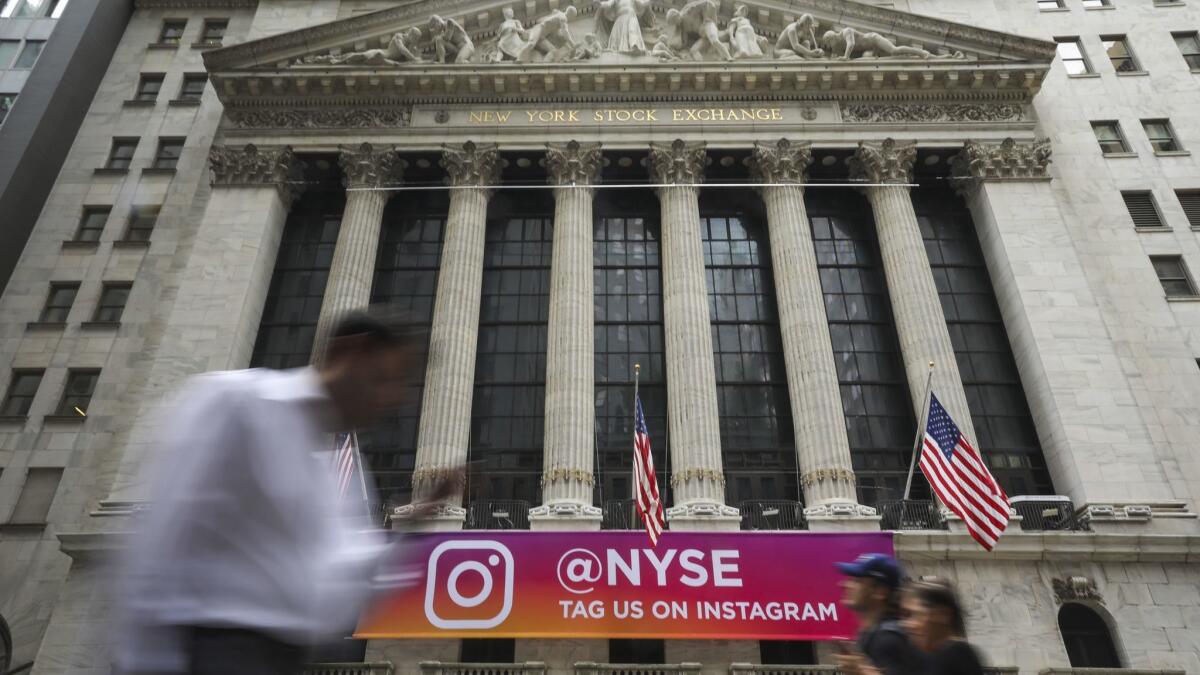‘America First’ investment theme may be concealing risks in U.S. stock, credit markets

- Share via
“America First” seems to have become an investment theme by default, as money managers turn to the U.S. in a fraught global environment. The danger is that movement may be concealing risks in the world’s safe haven.
The prospect of the strongest economic expansion since 2005 has helped draw investors to American markets. Geopolitical uncertainty is magnifying the move, despite rising domestic political risks. The percentage of global bond-fund allocations to the U.S. reached 62.6% in August, the highest since 2010, according to the Institute of International Finance.
If sustained, this demand could exacerbate distortions: Robust growth and Federal Reserve rate hikes haven’t managed to push 10-year Treasury yields above 3% for long, and credit spreads are near their tightest levels in a decade.
What’s more, a vicious cycle may be developing, in which U.S. sanctions and tariff threats are driving yet more cash toward American markets. Even with a decline over the last week, the Bloomberg dollar index is still up more than 5% since mid-April. The strength puts pressure on emerging economies, which have amassed about $3.7 trillion in dollar-denominated borrowings. One question for investors is whether the U.S. can remain immune to the strains its policies are creating in such markets as Turkey and China.
“The dollar debtors out there are all scrambling to find dollars and that contributes to the dollar strength,” said Joachim Fels, global economic advisor at Pacific Investment Management Co. But Fed rate hikes are gradually removing liquidity, “so the tide is going out and I think that will expose the weaknesses.”
The greenback’s recent bout of weakness also raises the question of how resilient U.S. assets will be in the face of domestic political risks, after President Trump’s former lawyer pleaded guilty to federal charges. While the economic backdrop and policies that support further dollar gains remain in place, the resulting uncertainty may give pause to investors seeking refuge in the U.S.
So far, the economy is on solid footing, allowing the Fed to tighten monetary policy, while the Bank of Japan and the European Central Bank continue providing stimulus. Riskier U.S. assets have found support in corporate earnings growth of 25% in the second quarter, which has driven the Standard & Poor’s 500 index to record highs. In contrast, the MSCI emerging-markets index is down more than 17% from its 2018 peak.
“Things in the U.S. are priced for perfection,” said David Kelly, chief global strategist at JPMorgan Asset Management. “There’s been a bit of a failure to launch in the rest of the world. We thought that the good momentum last year would be maintained into this year, and that really hasn’t been the case for places like [emerging markets] or Europe or even really Japan.”
U.S. credit markets seem particularly impervious to the forces buffeting global markets. But vulnerabilities may be building.
In investment-grade bonds, years of borrowing at cheap rates has fueled debt-driven mergers and acquisitions, and weakened credit quality. The proportion of bonds in the lowest tier above junk in the Bloomberg Barclays corporate index has jumped to 53%, from 38% in 2007.
The support for elevated asset prices may be tested soon. Fels is among analysts expecting U.S. growth to slow in the second half of 2018, and corporate earnings to weaken. The dollar’s strength could start to weigh on companies’ profits, Fels said, and the pro-cyclical policy of tax cuts and deregulation may prove to be a sugar high as the expansion enters its 10th year.
A few Fed officials also see fiscal stimulus as a potential head wind to growth, according to the minutes of the central bank’s latest meeting. Investors may not be ignoring these concerns, so much as struggling to measure them, as U.S. policy is in uncharted waters.
“Investors find it very difficult to deal with geopolitical risks in their portfolio construction,” Fels said. “It’s very different from other risks that investors deal with and are used to: interest-rate risk, credit risk and so on, where we have a lot of instruments to price them.”
More to Read
Inside the business of entertainment
The Wide Shot brings you news, analysis and insights on everything from streaming wars to production — and what it all means for the future.
You may occasionally receive promotional content from the Los Angeles Times.










